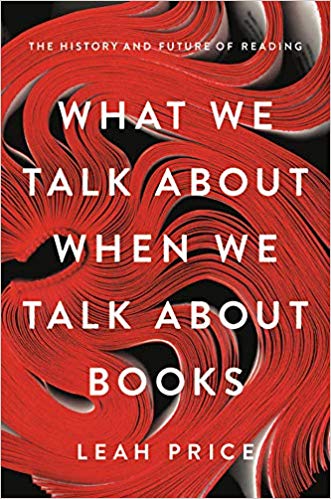You have /5 articles left.
Sign up for a free account or log in.
 What We Talk About When We Talk About Books: The History and Future of Reading by Leah Price
What We Talk About When We Talk About Books: The History and Future of Reading by Leah Price
Published in August of 2019.
Nowadays, we expect much from our books.
Readers who prefer paper look to books for not only entertainment and edification, but also to enforce a disconnect from the world of screen-based distraction. The paper book becomes both buffer and antidote to the allure of surfing, and the demands of the tweet and the e-mail.
Those of us who read digitally are perhaps looking to enhance the density of information in our lives. My audiobooks accompany my walks to work, my time washing dishes and folding laundry, and the hours that I spend exercising. E-books can be read on phones while in line at the deli counter and in the waiting room of the dentist office.
The genius of What We Talk About When We Talk About Books is to remind the reader that our expectations of books were once very different.
For most of the history of books printed on moveable type, moralists worried that novel reading was a distraction from more important pursuits. Where shutting out the world to give one’s full attention to a book is today considered a virtue, for most of the history of widely available books, this sort of behavior would be regarded as a vice.
One argument frequently heard against digital books, and Amazon’s Kindle and Audible products in particular, is that the buyer of e-books and audiobooks never actually own these purchases. When you buy an e-book or an audiobook, you are purchasing a license to read. The terms of purchase forbid re-selling or gifting the book.
As I learned in What We Talk About When We Talk About Books, most 19th and early 20th century readers were also book renters. Books were serialized in newspapers or circulated through private and public lending libraries. The idea of owning most novels once they were read would seem as odd as holding on to old newspapers and magazines.
Knowing that book ownership and book reading was not always synonymous does not lessen my frustration at not being able to pass along my digital books. The monopoly that Amazon has on digital books, and the onerous licensing terms that the company can enforce, should worry every book reader. Instead, it is good to put these concerns within some historical context.
What will the future of books hold? Price makes the case that books have always been at the leading edge of technological shifts. It was bookstores that first allowed shoppers to browse the stock and pick out their books, rather than ask a clerk to fetch a copy. It was books that first had barcodes and electronic tracking. When Bezos started Amazon, he picked books as the first product, as both their size and variety made books the perfect product to build an e-commerce empire.
Books also show us that new technologies seldom supplant existing ones. Despite the fear about the transition of books from atoms to bits, the number of paper books printed and sold each year continues to grow. Digital books complement, rather than supplement, their print siblings.
This history of physical and digital books living together in harmony should those who worry about the impact of online learning on residential education some degree of comfort. If higher ed follows books, then smart purveyors of physical experiences (such as neighborhood bookstores and residential liberal arts colleges), should find a way to navigate the digitization of education.
One of the messages of What We Talk About When We Talk About Books is that, in each age, book people tend to be worriers about books. In the past, the worry was that readers read too promiscuously. Today, the concern is that too few give too little attention to books.
Leah Price’s reassuring message is that all that book worry never got anyone anywhere.
If I’m ever to bring my idea for a platform for higher ed readers and academic authors to life, the first book that community will discuss will be What We Talk About When We Talk About Books.
What are you reading?




